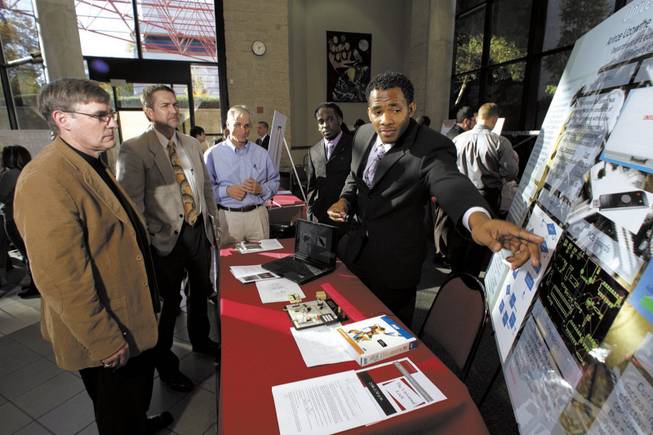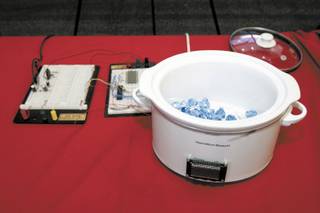
Arinze Uzowihe, right, with partner Festus Arichie, explains the workings of his invention, the “Universal Lock,” to judges, from left, Dick Hughes, Jerry Pruitt and Mark Fakler.
Sunday, Dec. 6, 2009 | 2 a.m.
Engineered for Greatness
UNLV engineering students competed for thousands of dollars of prize money Wednesday during at the Senior Design Competition at UNLV. Projects ranged from an electric recumbent vehicle, to a chocolate melting device, to a solar tracker that can channel sunlight indoors.
Sun Coverage
Sun Archives
- It's all nerves, gears and wires at annual robot contest (3-27-2009)
- Teen masters gather for a robot rodeo (3-29-2008)
Beyond the Sun
UNLV’s College of Engineering’s annual senior design competition is an opportunity for students to solve perplexing engineering problems from the everyday — a faster trip across campus — to the highly technical — smarter traffic signals and solar panels.
Dr. David Shields, a civil engineer who teaches in UNLV’s construction management department, walked the exhibit hall with the Sun last week and offered his observations on a few of the entries.
Chocolate Temperer
Electrical & Computer Engineering Department
Students: Rapheal Hicks and Vincent Poteat
A UNLV physics professor offered students this problem to solve: His wife, an amateur confectioner, was frustrated by the limited options for melting chocolate at home.
There’s the old-fashioned double-boiler method, which allows little room for error in estimating timing and temperature, and often turns expensive blocks of chocolate into a gritty mess. The other option is to buy a commercial-grade chocolate temperer, which ranges from about $300 to more than $2,500.
By rigging a microcontroller to an ordinary slow-cooker, Rapheal Hicks and Vincent Poteat were able to increase and decrease the temperature and liquefy the chocolate. The device has settings for white, milk or dark chocolate because each requires a separate temperature curve.
Hicks and Poteat call it their “Chocolate Tempering Device,” a name that doesn’t sound like it would generate brisk sales on QVC or the Food Network. But when asked if he could come up with something catchier, Poteat responded in minutes: “It’s the ‘Choc-Pot.’ ”
“It’s an attractive and affordable design,” Shields said. “There are probably a lot of home chefs who would like to have something like this in their kitchen.”
Recumbent Electric Vehicle (REV)
Mechanical Engineering Department
Students: Jonathan Burgos, Gregory Johnson and Rick Null
Costing just a half-cent per mile to operate, the REV is 21 times more efficient than a Honda Civic, UNLV senior engineering student Gregory Johnson said.
Able to comfortably fit an adult over 6 feet and hold up to 300 pounds, the electric bike accommodates just about anyone, Johnson said.
With no moving parts, the engine — powered by 48-volt batteries — should require little or no maintenance, he added.
He said he remembers taking apart his own tricycle to see how it worked when he was about 4 years old. Kitchen appliances were next, said his mother, Judy Johnson, who traveled from Grand Forks, N.D., for the competition. But he quickly progressed to putting things back together, said his father, Dr. Bob Johnson, an orthopedic surgeon.
The design team’s goal was to incorporate brushless motor technology and regenerative braking, making it both durable and easy to operate. The bike reaches speeds of 40 mph and has a range of more than 35 miles.
The next step will be to make the electric bike street safe, such as adding headlights, for further testing.
“The bike offers a nice solution to local commuting, particularly in areas where they don’t have much inclement weather,” Shields said. “The energy efficiency is impressive. I can see tourists in Las Vegas wanting to use it, too.”
Universal Lock
Electrical & Computer Engineering Department
Students: Festus Ariche and Arinze Uzowihe
Arinze Uzowihe’s girlfriend is a bank teller, and lugs around a heavy chain with the many keys she needs for her job. She wears a plastic coil bracelet with her personal keys, as well.
“It’s cumbersome and annoying,” Uzowihe said. “Actually, it drives me crazy.”
And it drove him to invent a universal lock system that would allow an individual to gain entrance to everything from a car to an office to a desk drawer, all with the same device.
The size of a portable USB storage key, the universal lock would be programmable using specialized software. If the key were misplaced, the user could still gain entrance using a keypad code. And if the key were stolen, the user could immediately disable it via the software or keypad.
“You know who else has to carry a lot of keys?” Shields said to Uzowihe, “University professors.”
Shields pulled out an oversized ring with dozens of keys to various doors and drawers in the engineering department. He also carries plastic pass cards.
“I’d buy it,” Shields said of the universal key system. “It would mean a lot fewer holes in my pants pockets.”
The Curf Board
Mechanical Engineering Department
Students: Erol Dizon and Patrick Pellacani
Patrick Pellacani has tried just about everything to speed his cross-campus treks, including using a scooter and skateboard. Neither allowed him to take corners with ease.
With small springs attached to its wheels, “Curf Board” offers better turning capability, as the rider shifts his weight from side to side as a surfer might. The resistance from the springs allows the rider to keep his forward momentum without having to dismount.
Shields liked that the wheels could be used to upgrade any existing skateboard, and also incorporated some fundamental principles of physics, showing the students had done their homework.
Shields noted that during his student days in Southern California in the 1960s he had a skateboard, one of the original models that was little more than a flat board attached to roller-skate wheels.
Pellacani offered to “hook up” Shields with a custom-built “Curf Board,” but the professor declined.
“I think I’m too old and brittle for it now,” he said with a laugh.
Integrated Traffic Control
Electrical & Computer Engineering Department
Students: Kyle Donohue, Jin Kwon and Bruce Moore
The Nevada Transportation Department controls the pace at which traffic enters state-run highways using ramp meters. But it’s cities that are responsible for setting traffic-signal patterns at the intersections leading to the on-ramps.
The integrated traffic control device allows locally controlled traffic signals to self-adjust so that fewer cars are backed up waiting to get on the freeways.
Studies have found that the average motorist spends 36 hours a year stuck in traffic.
“It would be great if we could give people even a few of those minutes back,” Kyle Donohue said.
The students’ work has attracted the interest of the Regional Transportation Commission, which offered guidance and technical support.
Shields was impressed not only with the common-sense approach the students took to improving traffic control, but also with the comprehensive presentation explaining how traffic-control patterns could be tested and adjusted.
That also bodes well for the project’s chances of winning support from municipal bosses, he said. “That’s what managers like: visual demonstrations of technology.”
Solar Tracker
Electrical & Computer Engineering Department
Students: Herb Akinyele, Sean Andersen and Justin Williams
On the roof of the engineering building at UNLV is a parabolic mirror that concentrates the sun’s rays into a fiber-optic cable. When the motorized controller that positions the mirror to maximize its efficiency broke, the manufacturer said it would cost $10,000 to fix. Professor Paolo Ginobbi challenged his students to figure out a way to do the job on their own.
The result: the “Solar Tracker,” which not only replicates the original device’s capabilities, but also allows for more precise positioning.
The job was completed for about $600, said Sean Anderson, a UNLV senior.
“You have to produce this thing,” Shields told Anderson. “And find the other company’s customer list.”


Join the Discussion:
Check this out for a full explanation of our conversion to the LiveFyre commenting system and instructions on how to sign up for an account.
Full comments policy